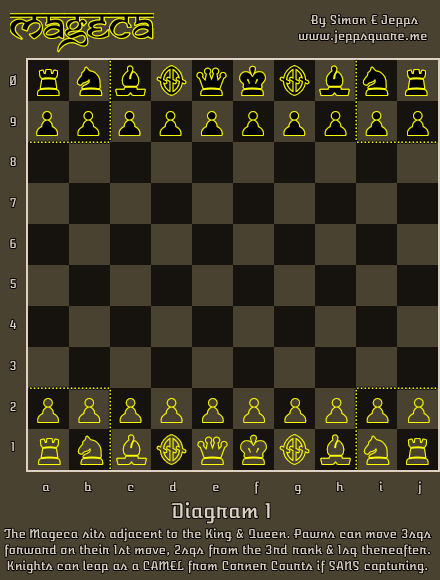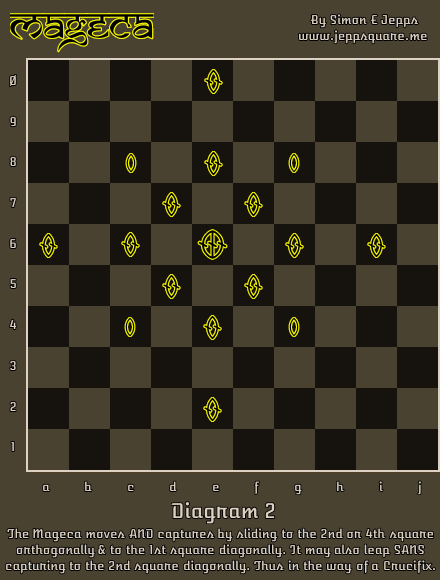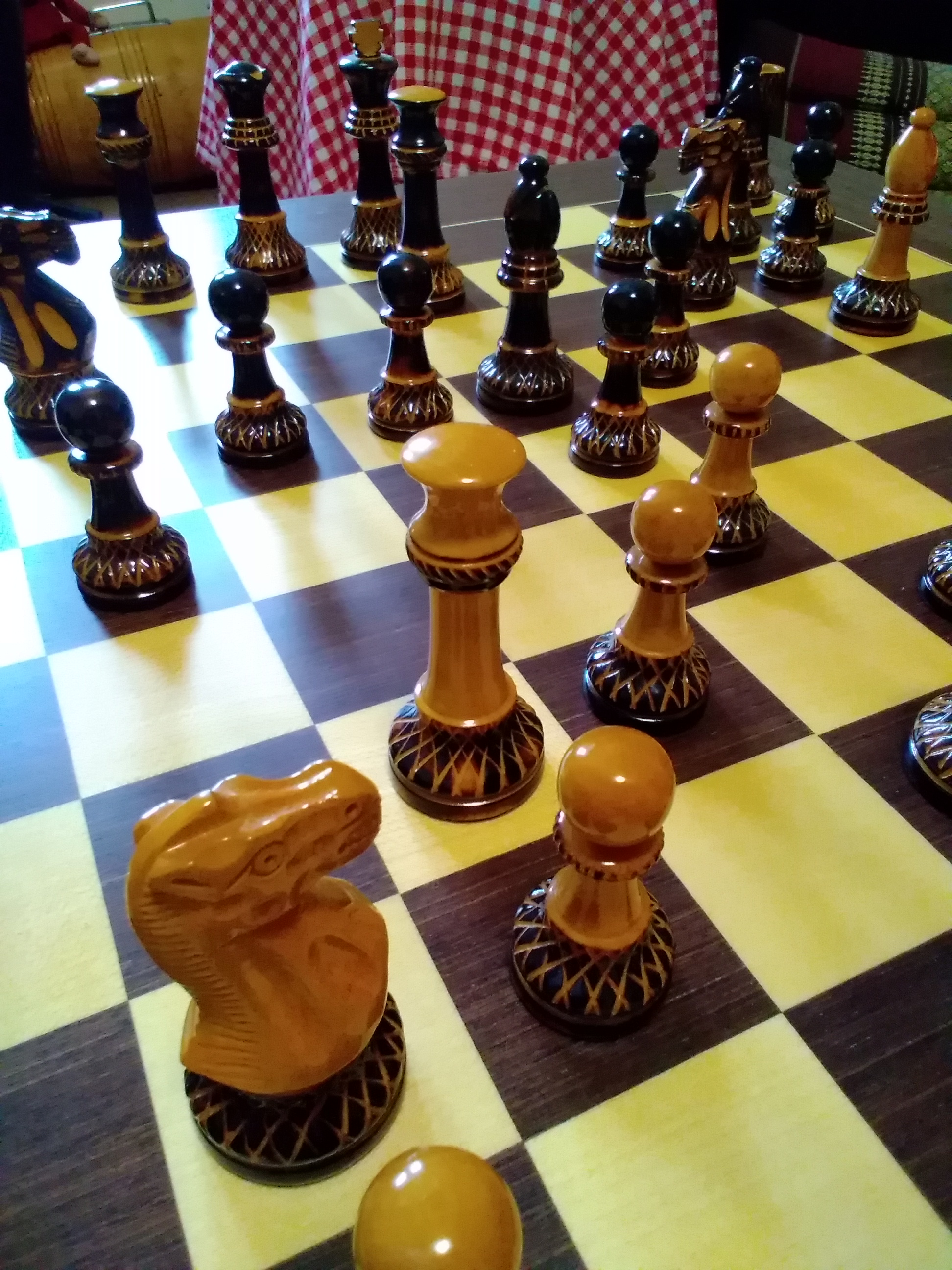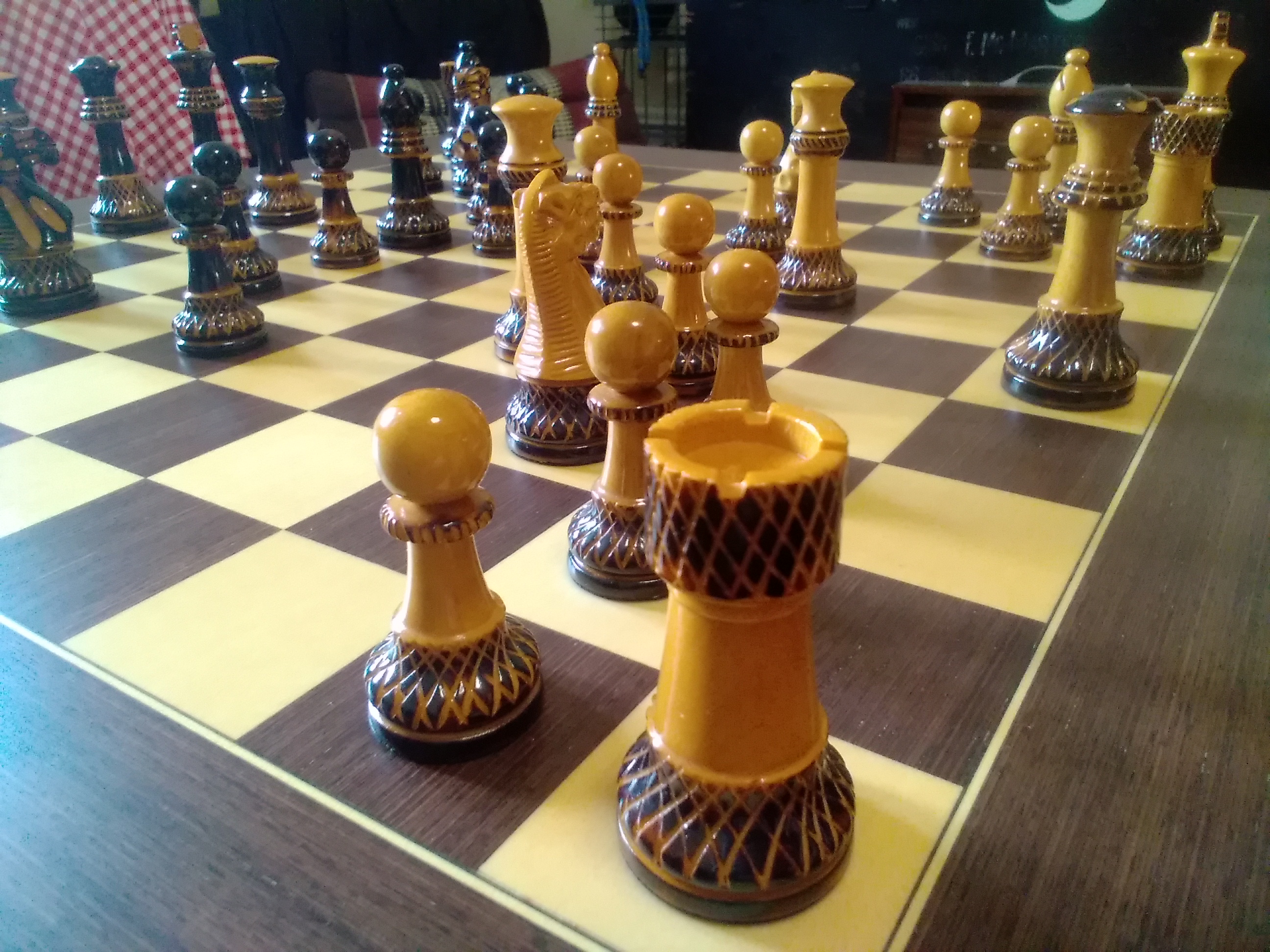MAGECA
A Chess Variant By Simon Edward JeppsDownload ~ PDF ↷ ⋱
Introduction
 Mageca Chess is a variant I have designed to ultimately address and remedy the problems associated with evolving Chess unto a 100sq board.
Mageca Chess is a variant I have designed to ultimately address and remedy the problems associated with evolving Chess unto a 100sq board.
Theoretically it is true, the 10x10 board is the most logical step forward unto the next evolution of Chess, but most people will not play on such a board for various reasons.
- Due to the extra squares and increased distance between armies, vast spaces are created around pieces in play, particularly the Pawns, reducing their ability to form defensive communities.
- Due again to the increased distance between armies, fast punching hand to hand combat is practically non existant during the Opening stages, resulting in a more recumbant and passive kind of warfare.
- Shorter range pieces such as the Knight become greatly weakened on a larger board, whereas infinite range pieces such as the Bishop become much, much stronger. Thus, whence on the Classical 64sq board, they were once equal comrades.
- A larger board requires new leaper pieces with longer strides, such as the Omega Wizard, but this means Check of the King can be delivered far too early and far too easily.
For example, the diagonal naturally provides for the Bishop, the orthogonal provides for the Rook, both of these provide for the King, Queen and Pawns... and the only easily identifiable "special move", the "L" shape, provides for the Knight.
Any other "invented movement" for a new piece is only going to reflect the desires of its inventor and will therefore not harbour a "naturally provided" character embraceable by all players.
So here one has to ask, if it has been 100 years since the world champion José Capablanca proposed his own Chess variant and yet the world has still not evolved the game into any new species... then what is the paradox we need to solve?
Aye, in a moment I will explain how I believe I have remedied these problems with the 100sq board and even how I believe I have discovered the only possible remaining "naturally suggestive" movement of a new piece ~ but first let us look at the problems with the 64sq board and the reasons why we must evolve unto the larger arena.
There are many ailments and problems with the 64sq board and I will now list a selection of them.
- A compromised Knight from move one.
- Lack of flank Openings.
- Berlin Style Queen exchange.
- Blocked in or "bad" Bishops.
- Opposing fianchettos.
- Frequency of draws amongst masters.
- Restricted creativity for tournament players.
You only have to look at the Knight to realise there is in fact only ONE practically useful square for it to move to, in the vast majority of cases ~ K/QB3 ~ and that is even less than a Pawn!
Granted there are a total of 20 possible first moves alone... and well, you can do the maths. But in reality only a handful of these are actually worth one's time and sanity to pursue.
Herewith, if the only way to enjoy the creative essence of the game, is to obtain a PHD in mathematics and study a handful of Openings at the atomic level, then we may as well put away the Chess board right now. Yes of course, the whole purpose of the game is indeed to study all the common Opening strategies and some less common ones, until you can delve really deep into the genetic make-up of every position.
Yet, the problem with the 64sq game is it has evolved only to entertain the intellectually elite ~ aye, it does NOT matter how good you are for there will always be a worthwhile opponent of your own strength to enjoy ~ but if you are stuck in between the realms of very strong but not a Grandmaster, then what you find is a LACK of study material and a LACK of creative opportunity.
Why? Because whilst you are very good at studying quite deeply the common handful of acceptable Opening strategies ~ it is only this handful of mostly-non-flank central Opening squares to keep you entertained ~ and you are not very good at delving into the atomic levels of plentiful moves ahead. Thus you become bored by the restricted creativity available to you.
Aye indeed, new flank ideas are always emerging, such as the Mujannah Opening ~ PDF ↷, one I very much adore myself, but it is this very limitation of alternative first moves which casts a depression over the average tournament player's game.
After four decades now of playing Chess and seeing the same old Kt-K/QB3 pin over and over again, my mind has simply decided, "NO - we need a better game."
Now behold... a, b, c, d, e... f, g, h, i, j... these are the squares we will now play.
Playing Mageca Chess
 Mageca Chess is played on a 100-square 10x10 checkered board, featuring a new Piece, the Mageca, and additionally the curiosity of a CAMEL move for the Knight. All other Classical Chess rules, apart from a minor 'adjustment' to Castling & En Passant, remain the same.
Mageca Chess is played on a 100-square 10x10 checkered board, featuring a new Piece, the Mageca, and additionally the curiosity of a CAMEL move for the Knight. All other Classical Chess rules, apart from a minor 'adjustment' to Castling & En Passant, remain the same.
The FILES are labelled a~j and the ranks 1~Ø. The board is positioned with a Black Square to the player's Right Hand, in order to maintain the 64sq practise of placing the central Queen on her own coloured square.
We use a 'crossed zero' instead of '10' because it is much easier and quicker to write down during fast game notation and because it docks much more cleanly into a diagram, remaining in line with all the other numbers.
PAWNS may move a maximum of Three Squares forward on their First move and a maximum of Two Squares forward from the Next/3rd Rank.
EN PASSANT is legal when a Pawn advances two or three squares forward in a single move, but only if the advancing Pawn arrives horizontally adjacent to the opponent Pawn.
Mageca Chess also gifts a new rule unto the Knight in compensation for its limited range within the greater 100sq arena.
KNIGHTS sitting in Corner Courts {the 4 squares in each corner (2x2,x4=16 total)} may Leap as like a CAMEL {an elongated Knight (3x1 as opposed to 2x1)} but only WITHOUT CAPTURING.
KING Castling is the same as in Classical Chess except the King must now move Three Squares towards the Rook.
The Science Of The Mageca Chess Board
All the ailments associated with the 64-square board that I mentioned in the Introduction are addressed and remedied through the Mageca Chess board.1. A compromised Knight from move one.
Whilst the Knight remains in a Classical near-edge starting scenario, it has the added benefit of a non-capturing CAMEL leap from its starting square. Also, whilst an early Knight pin in Mageca Chess is still of a similar irritation value, it is nevertheless avoidable, primarily again through increased Opening move options but of course also through a possible Mageca intervention.
2. Lack of flank Openings.
An interesting study I conducted ~ PDF ↷ reveals that whilst it would be nice to have more flank Openings to choose from, it is not necessarily so much the number of flank Pawn outposts which make new Opening strategies interesting, but the subtle augmentation of dynamically collective piece placements. Thus, what I mean is, whilst Mageca Chess does indeed provide many more options in the way of flank Openings, it moreso provides an "augmented desktop" upon which to plan out new and interesting piece placements ~ something which has likewise become exhausted in the 64sq arena.
3. Berlin Style Queen exchange.
Sure enough, the same scenario of an early Queen exchange due to unfortunate Pawn interactions is still a possibility, but in all honesty, not only is this only a trivial matter and one of Opening astuteness, but in Mageca Chess it can be more easily prepared for through subtle preparations of the additional pieces and through the freedom of some increased refuge routes for the King.
4. Blocked in or "bad" Bishops.
Of course here is an irrefutable benefit of the 100sq board, in that Bishops have many more escape routes, yet Mageca Chess remedies this even further through the increased flexibility of Pawns and their ability to vary their advance from different ranks. In effect, if an escape route does not already exist, the increased flexibility of Pawns makes creating one much easier.
5. Opposing fianchettos.
I had originally considered placing the Knight & Bishop closer to the King & Queen, which would completely remove the problem of opposing fianchettos... but in all honesty, not only does the 100sq board make the phenomena less irritable through the intervention of more central Pawn placements, but in truth we should embrace Classical concepts and bring them forward regardless of their negativities... for let's face it, opposing fianchettos are nevertheless great fun to mitigate!
6. Frequency of draws amongst masters.
Obviously since this is primarily due to the 64sq game having been "played out" by masters, it is inevitable that a new evolution of the game into a much larger playing board will deliver unto the world a whole new cosmos of algorithms and puzzles to solve. This is of course an absolute objective of Mageca Chess and I am sure that this game will provide millions of people for hundreds, if not thousands of years to come, with unrivalled intellectual satisfaction and entertainmemt.
7. Restricted creativity for tournament players.
As mentioned earlier, the 64sq game has evolved only to entertain the intellectually elite; in that if you are stuck in between the realms of very strong but not a Grandmaster, then what you find is a LACK of study material and a LACK of creative opportunity ~ because you have reached a very high yet finite summit without the needed powerful knowledge of flight. Mageca Chess of course completely solves this paradox with the deliverance of more squares, more pieces, more specialties, more Opening strategies and thus an infinite progression of intellectual creativity for all skill levels of all players.
Playing The Mageca
 As a tribute to my Father who taught me Chess and unto my family, the Mageca actually gets its name by combining the first two letters of my Mother's, Father's & Sister's names: Maria, Gerald and Catherine.
As a tribute to my Father who taught me Chess and unto my family, the Mageca actually gets its name by combining the first two letters of my Mother's, Father's & Sister's names: Maria, Gerald and Catherine.
I have always liked the concept of a "Wizard" piece in Chess, but as mentioned earlier regarding long-leaper pieces, I did not feel the Omega Wizard piece to be the ultimate candidate, although inspirational.
So herewith I have invented my own piece of a similar theme. It should be noted however, the Mageca is not so much a 'Wizard' in the conventional sense, but moreso an 'other worldly transcendental being' or 'outer-realm entity' of great magical spirit. Or at least, that's how I invisage the piece.
Consider it a "magic mage" if you prefer!
The movement pattern of the Mageca, whilst a little unusual perhaps, is actually extremely easy to learn and furthermore it is what I believe to be the only possible remaining "naturally suggestive" movement of a new piece.
Behold... for in truth there are actually TWO "naturally suggestive" moves remaining to be discovered! Yes... and these are:
- Firstly, the colour-bound Rook; meaning an orthogonal slider but which can only arrive to a square of the same colour to that which it vacated.
- Secondly, the shape of a Crucifix; sure, Chess originated in India thousands of years ago, but in all honesty, we may aswell embrace our own spiritual culture!
The Mageca:
- Moves/Captures by Sliding to the 2nd or 4th Orthogonal square away & to the 1st Diagonal adjacent square. Optionally it may Leap WITHOUT CAPTURING to the 2nd Diagonal square away.
- Note: The Mageca must EITHER move orthogonally OR diagonally ~ it may NOT combine movements!
- STARTS the game adjacent to the King & Queen on d1/dØ/g1/gØ.
Firstly whence playing a 100sq board you will find Pawns are much more vulnerable due to the increased distances between them, making it difficult for them to form defensive communities. The central Pawns are paramount to Opening play and so the Mageca here provides the vital defensive support needed to replenish that lost through the transition from 64sq to 100sq.
Secondly whence playing a 64sq board you will find all pieces are placed in a way which not only ensures all Pawns are defended on their starting positions, but also so that all pieces can develop in an evenly distributed and logically flowing manner. The Mageca is here placed in order to allow all of this without compromise or confliction.
Whilst it could be argued that a "wizard-like" piece belongs on the outer realms, or as such a corner square like in Omega Chess, placing it there disrupts the Classically familiar routines of corner-castling with fianchettos and leaves the central Pawns to fend for themselves in a new immensly imposing arena.
The Science Of Mageca Chess Gameplay
All the ailments associated with the 100-square board that I mentioned in the Introduction are addressed and remedied through Mageca Chess gameplay.1. Due to the extra squares and increased distance between armies, vast spaces are created around pieces in play, particularly the Pawns, reducing their ability to form defensive communities.
Mageca Chess remedies this through the ability of Pawns to advance more flexibly; so the need to choose between a 3sq or 1sq advance is actually irrelevant due to the 2sq advance allowed from the 3rd rank. Also the Mageca piece has been specifically designed to provide exactly the balanced presence necessary to work with and amongst Pawns, effectively creating a virtual Pawn presence in its footprint.
2. Due again to the increased distance between armies, fast punching hand to hand combat is practically non existant during the Opening stages, resulting in a more recumbant and passive kind of warfare.
The 100sq board game with two rows of pieces, as would be the natural Classical evolution, will always result in a more "recumbant" style of Opening play, this is unavoidable. Mageca Chess however somewhat remedies this through again the improved flexibility of Pawns, but moreso significantly through the granting of a CAMEL move unto the Knight, allowing it to instantly replenish its Classical presence familiar on the 64sq board. Indeed also of course, the Mageca piece itself has been specifically designed to likewise provide a unique striking character of mid-range influence on the board, effectively reducing the "virtual" size of the board and thus replenishing the faster paced action familiar in a smaller arena.
3. Shorter range pieces such as the Knight become greatly weakened on a larger board, whereas infinite range pieces such as the Bishop become much, much stronger. Thus, whence on the Classical 64sq board, they were once equal comrades.
As mentioned earlier, Mageca Chess remedies this through the providing of a CAMEL move unto the Knight whencever it sits in a Corner Court {the 4 squares in each corner (2x2,x4=16 total)}. Allowing an elongated "boost" seems only natural, but only as a NON-CAPTURING move. Pawns already have a 'special' move to help them advance, so why not also the Knight? Why the bias? Exactly, it only makes sense. Also again the Mageca is specifically designed to be the half-way point between Knights and Rooks so neither the weaker nor the stronger work from an uncollaborative distance.
4. A larger board requires new leaper pieces with longer strides, such as the Omega Wizard, but this means Check of the King can be delivered far too early and far too easily.
The TWO SQUARE DIAGONAL leap of the Mageca is actually quite a long distance, compared to the Knight and whence paired with the Mageca's FOUR SQUARE ORTHOGONAL slide, it truly claims for itself exactly the balanced presence required of the game, without risking any unwelcome early Checks of the King.
Furthermore the Mageca:

- Employs only remaining naturally suggestive move.
- Replenishes balance between leapers and colour-bounds.
- Moderates virtual size of board dynamically as pieces are taken.
A Natural Move
You may recall my mentioning at the beginning, how the next evolution of Chess could only possibly arise if the newly proclaimed 'piece' to take its place on the 100sq board likewise features a character of movement only naturally suggested by the board itself.Otherwise, any "new piece" invented for any bigger board will have to feature an invented movement not naturally provided for by the characteristics of the board and thus will not be welcomed by all players.
To reiterate for example, the diagonal naturally provides for the Bishop, the orthogonal provides for the Rook, both of these provide for the King, Queen and Pawns... and the only easily identifiable "special move", the "L" shape, provides for the Knight.
Any other "invented movement" for a new piece is only going to reflect the desires of its inventor and will therefore not harbour a "naturally provided" character embraceable by all players.
Herewith is where the Mageca proves its "natural" worthiness, for if you look carefully at its footprint you will behold its dancing to be in the shape of a Crucifix. Wherefore it stands at the head of the cross, its firm diagonal step unto the arms of the cross, its long powerful stride unto the torso & unto the foot of the cross and finally its graceful diagonal leap the deliverance of sacred truth.
This design was not primarily sought by myself, but in actual fact evolved of its own destiny to become its own design in mutual collaboration with my mind and the board as I studied and investigated the different mechanics of my working piece.
This is because in truth the colour-bound Rook is the other only remaining natural movement and thus it is here where my investigations actually began. From here I realised it needed more prowess and influence about the greater space of the 100sq board. Thus evolved the diagonal step and eventually the two-square diagonal leap, ultimately delivering the final form of the Mageca in the portrayal of a Crucifix.
I truly believe therefore that since only the board itself could decide the eventual design of a new piece, that the Mageca MUST be without doubt, the next evolution of Chess.
A Balanced Piece
Looking at the 64-square board we see the Classical array of pieces is already imbalanced, it is overweighted by sliding pieces of both long and short range and yet ONLY ONE leaping piece, the Knight, to escape a stale barricade.Likewise and vice versa, we see another imbalance, the board is underweighted by colour-bound pieces, simply featuring the Bishop in this role, whereby the entire remaining array can pick and choose any colour square they wish.
Thus a new leaping piece is required, but which is both short/long range without overpowering the board AND a new colour-bound piece is required. The Mageca fulfils ALL of these criteria.
A Dynamic Board
One fantastical characteristic of the Mageca is its seeming continuum of dynamic influence upon the virtual size of the playing arena, or board. The 100-square adaptation of Chess has always been a love-hate relationship, even amongst Grandmasters, yet herewith is where the Mageca performs almost something akin to a "miracle" as it seems to nurture the very sands of Chess tempo and the very shape of the Chess board itself.What I mean is, due to the Mageca's trait of both short/long range & (semi-)colour-bound movement, its prowess remains somewhat restricted during the Opening, yet actually becoming gradually stronger as more pieces are taken and thus more squares become available to it, until eventually in the Endgame the Mageca controls a considerable field area, unintimidated by Pawns.
As such, the "virtual board size" is thus also directly and dynamically controlled by the Mageca, in that its own footprint diminishes free space without closing it entirely and in turn moderates the flow of interaction dynamically unto an eventual open equilibrium of a likewise relatively-moderated "spacial" Endgame.
Whilst evolving to a 100 square board would be ideal, due to the extra squares and increased distance between armies, vast spaces are created around pieces in play, reducing their ability to form defensive communities.
Yet the Mageca automatically adjusts the "playing dimensions" on the board's behalf and thus adapts itself to this ever changing board-dynamic, continually "evolving" to provide exactly the correct balance of piece-square-presence throughout the game.
A true team player!
Notation, Castling & En Passant
Notation
The Mageca piece is notated with an "M". The files are labelled a~j and the ranks 1~Ø. The board is positioned with a Black Square to the player's Right Hand, in order to maintain the 64sq practise of placing the central Queen on her own coloured square.We use a 'crossed zero' instead of '10' because it is much easier and quicker to write down during fast game notation and because it docks much more cleanly into a diagram, remaining in line with all the other numbers.
Whence communicating through Chess diagrams or computer interfaces, any kind of icon may be used, since even Classically there are no rules.
Castling
King Castling is the same as in Classical Chess except the King must now move THREE squares towards the Rook. Notation remains the same however because the terms "0-0" and "0-0-0" actually refer to the number of squares the Rook must move in order to land beside the King's far shoulder. Thus aka; 'Long Castle' & 'Short Castle'.En Passant
When a Pawn advances two or three squares forward in a single move, the Classical law of En Passant applies, but ONLY if the advancing Pawn arrives horizontally adjacent to the opponent Pawn.Unlike in Omega Chess where En Passant is legal even if the Pawn advances past the opponent Pawn, in Mageca Chess the two Pawns must be horizontally adjacent for the En Passant capture to be legal. Pawns of course are the soul of any Chess game and so their conversation with the 100sq arena is inevitably of a different character.
Indeed, so much so in fact that if we do not preserve their depth of participation, then any 100sq variant will certainly fail.
Increasing the frequency of Pawn capture through more instances of En Passant is therefore actually detrimental to the conversational depth & continuum of the game. Moreover, on a 100sq board Pawns find it much harder to get into the game at the beginning and so increasing the likelihood of 1st move captures is merely frustrating and counter productive to the logical continuum.
Mageca Chess retains the Classical depth & continuum of conversation by moderating this vital ratio of En Passant occurances and thus maintaining a good population of Pawns in dialogue.
Summary
 If you have read this far then you would be someone who is equally intrigued by the fact that regardless of how many thousands of Chess Variants have been invented in the world and how many artisans are prepared to create and sell Chess Variant equipment for the cause ~ my own pictured is actually a Jester Chess set by Masters Games, sadly now discontinued ~ we still to this day continue to play the Classical 64-square game.
If you have read this far then you would be someone who is equally intrigued by the fact that regardless of how many thousands of Chess Variants have been invented in the world and how many artisans are prepared to create and sell Chess Variant equipment for the cause ~ my own pictured is actually a Jester Chess set by Masters Games, sadly now discontinued ~ we still to this day continue to play the Classical 64-square game.
Yet notice I didn't say "prefer to play...", for in truth the next evolution of Chess is very much a 'Chinese Puzzle' or something akin to 'The Holy Grail' ~ it is a neverending pursuit to bring salvation unto the world, where every single turn and door always leads us back to square one.
I hope here with Mageca Chess to at least have opened a window unto greener fields ~ at least I am content myself with the game. I have never sought fame for my work, only appreciation, for in truth a good game is purely for the passing of good time between good friends... And indeed, good strangers.
Thank you for reading.
 |  |


